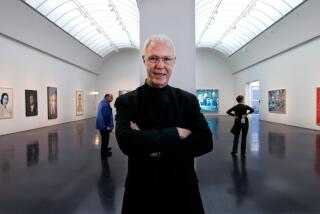SERIOUS CAL-ARTS FARE--AND ‘ENTERTAINING’ TOO
Contemporary music has a bit of an image problem, according to Frans van Rossum. “I don’t know why new art and music always have to be labeled as somber and serious.”
In that light, Van Rossum, dean of the music school at CalArts, turns to the 11th CalArts Contemporary Music Festival, presented as part of New Music Los Angeles. As director of the three-day fest, which opens Thursday at the Japan America Theater and concludes next weekend at the Valencia campus, he has taken pains to assemble a wide assortment of concerts, exhibits and installations that he promises will be “entertaining.”
That seems the last word one might choose to describe the work of John Cage (who will be present for a 75th birthday tribute next Sunday), Charles Wuorinen, Luciano Berio and the rest. Van Rossum, however, sees it differently.
“You can take entertainment very seriously,” he says. “A lot of people do. I think audiences enjoy something that makes them think or be puzzled. And that’s the mark of good art. What we will be trying to do is show pieces that would not be available anywhere else.”
As an example, Van Rossum points to a daylong presentation on Saturday of tapes from American and European Electro-Acoustic studios. Visitors can come and go, he says.
“They can lounge on sofas or pillows, listening and gazing out the window. People seem to get uneasy with taped music in a concert hall, so this gives them a comfortable space to listen.”
That exhibition may be the only chance for festival visitors to kick back at Valencia, since events run continuously over the two days. It’s all according to plan, he says.
“We have people come here from as far away as San Diego, San Francisco and Las Vegas. They’re not going to come for just one or two concerts.” The busy schedule also benefits Los Angeles residents, who must make the 40-mile drive out to the Magic Mountain area.
“I hope that they come out of curiosity,” Van Rossum said. “You know, new music is much more accessible now than, say, in the ‘50s, when everything was particularly rigid and experimental. These days, it’s more involved in absorbing and synthesizing things that have been created in recent decades.”
Cage, he notes, stands as a symbol of the numerous changes music has seen.
“We’ll be mostly concentrating on his early contributions, since his appearance at the Los Angeles festival in September will be in conjunction with performances of his more recent works.” The venerable composer “still has, in all aspects of art, tremendous influence,” Van Rossum says. That influence extends to the student composers at CalArts.
“While our students learn the rigors of strict classical training, they must deal with artists who are concerned about today, rather than copying the past. We are concerned with the living arts, but we’re not cutting off our roots. Rather, we’re emphasizing that tradition makes its own sense in the present.”
AT THE PHILHARMONIC: This week, Pierre Boulez will lead the Los Angeles Philharmonic at the Dorothy Chandler Pavilion in a 20th-Century program, as part of the New Music Los Angeles ’87 Festival. The agenda Friday through next Sunday lists music by Boulez--his own “Notations” I-IV--and by two other “B’s” of 20th-Century music--Bela Bartok and Luciano Berio. The latter will be represented in the West Coast premiere of his “Corale” for violin (Mark Kashper), two horns and strings, while Bartok’s “The Wooden Prince” will received its first Philharmonic performances.
Boulez returns to the Philharmonic podium next week for more music by Boulez, as well as Stravinsky.
Also this week, under Philharmonic auspices, is a joint recital Monday at the Music Center by Rudolf Firkusny and Lynn Harrell, playing music for piano and cello by Martinu, Schubert and Chopin.
More to Read
The biggest entertainment stories
Get our big stories about Hollywood, film, television, music, arts, culture and more right in your inbox as soon as they publish.
You may occasionally receive promotional content from the Los Angeles Times.










